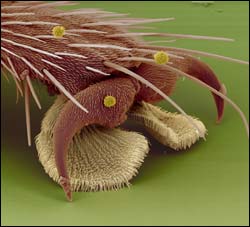Oh, what a feeling – dancing on the ceiling!

"Electron microscope image of a fly foot" (Supplied by S. Gorb)
The team led by Stanislav Gorb used optical sensors to measure the forces applied by each leg of a fly whilst walking freely on a smooth ceiling. They found that the best attachment force occurred when at least one leg from each side of the fly’s body was in contact with the surface. These principles were then proven using artificial polymer tape to simulate the adhesive pads found on the feet of insects.
“Walking on a ceiling is very different from normal walking because the gravity tends to pull an inverted insect away instead of pressing it to the surface”, explains Dr Gorb. “Our results, in combination with the knowledge on the microstructure of pads, provide important inspiration for mimicking locomotion of wall and ceiling walking machines, which use micropatterned polymer feet for generating adhesion”.
Dr Gorb will be presenting his results at the Annual Meeting of the Society for Experimental Biology on Wednesday 5th April [session A7].
Media Contact
More Information:
http://www.sebiology.org.ukAll latest news from the category: Life Sciences and Chemistry
Articles and reports from the Life Sciences and chemistry area deal with applied and basic research into modern biology, chemistry and human medicine.
Valuable information can be found on a range of life sciences fields including bacteriology, biochemistry, bionics, bioinformatics, biophysics, biotechnology, genetics, geobotany, human biology, marine biology, microbiology, molecular biology, cellular biology, zoology, bioinorganic chemistry, microchemistry and environmental chemistry.
Newest articles

Sea slugs inspire highly stretchable biomedical sensor
USC Viterbi School of Engineering researcher Hangbo Zhao presents findings on highly stretchable and customizable microneedles for application in fields including neuroscience, tissue engineering, and wearable bioelectronics. The revolution in…

Twisting and binding matter waves with photons in a cavity
Precisely measuring the energy states of individual atoms has been a historical challenge for physicists due to atomic recoil. When an atom interacts with a photon, the atom “recoils” in…

Nanotubes, nanoparticles, and antibodies detect tiny amounts of fentanyl
New sensor is six orders of magnitude more sensitive than the next best thing. A research team at Pitt led by Alexander Star, a chemistry professor in the Kenneth P. Dietrich…





















